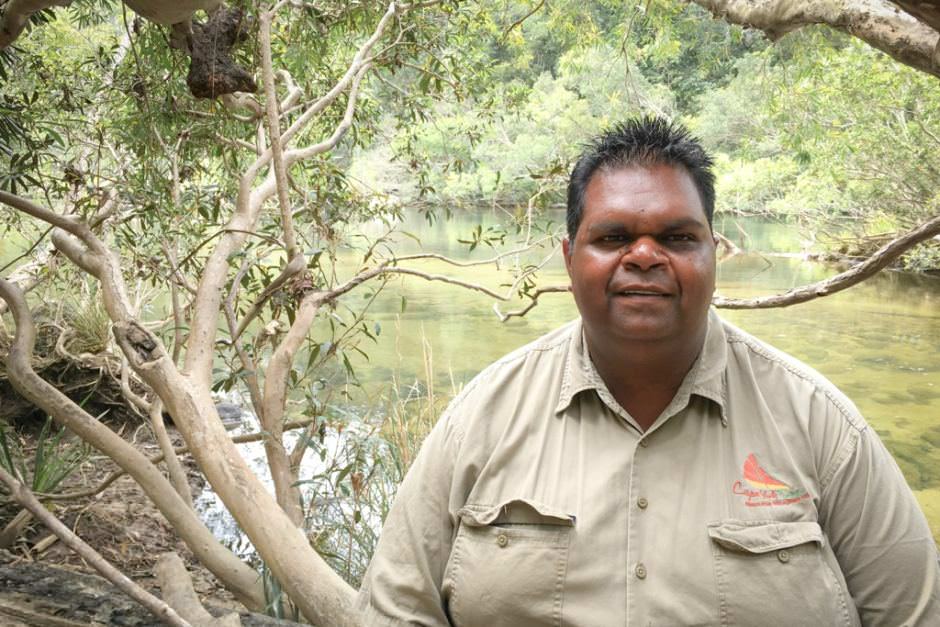
By Charlie McKillop and Phil Staley – Updated 6 Sep 2016
Click here to view the original news article.
“Where you see the roots sticking in the air and the canopy on the ground; thick on the ground and thin on the top.”
He points to several of the large parent trees whose tall trunks tower above the understorey.
Some have long black scars extending from the ground to several metres above our heads while others appear completely blackened and lifeless.
“You can see from the state of them, the hot fires have come and just been way too hot,” Mr Steffenson explained.
“And when we look at the forest floor, there’s no shade from these big bloodwood trees anymore [so] eventually, if we don’t do anything, more hot fires will come and all the black wattle that’s thickening the understory will burn hot again.
“All we’re going to have is dead wood, rubbish and more black wattle coming up and less grass.”
Learning from elders and the past

But what Mr Steffenson described was not immediately obvious to the untrained eye.
That’s because the young Indigenous fire practitioner’s eyes were focussed as much on the past as they were on the current scene before us.
Mr Steffenson learned to read the landscape while living and working alongside elders such as the late Dr Tommy George and George Musgrave from Laura in Cape York Peninsula.
Through stolen generations and separation from their original lands, some traditional knowledge had already been lost.
So, he began to record it and soon realised traditional burning was a vital link between the past and the way forward for healing country.
“The land was really sick and the younger generations were missing out on that knowledge,” Mr Steffenson said.
“Fire is the key and the first, fundamental management for getting country healthy again.”
Gathering on Cape York to share knowledge

For the past eight years, traditional owners from Tasmania, Victoria, New South Wales, Queensland and the Northern Territory have gathered on Cape York to share traditional fire knowledge.
This year, near the tiny, remote town of Wujal Wujal — about 350 kilometres north of Cairns — organisers from the Cape York Natural Resource Management (NRM) Group also challenged non-Indigenous Australians to learn and recognise the role of traditional burning in saving flora, wildlife and potentially, people’s lives by preventing large-scale bushfires.
Fire knowledge must be harnessed, not feared
Cape York NRM’s Peta-Marie Standley said most people who had experienced the devastating loss of life and infrastructure of uncontrollable bushfires were understandably scared of them.
“People talk about fire as though it is just one thing but it’s not. Cool fires heal the country and hot fires damage it,” Ms Standley said.
“At some point, non-Indigenous land managers and government and agencies need to actually consider there is a vast wealth of knowledge that has existed in this country for a significant period of time that could benefit us as a society.”

Through the Indigenous fire workshops, Ms Standley and Mr Steffenson created a platform for not only sharing knowledge, but also to broaden conventional, or mainstream thinking about fire management.
“It’s about healing the land; it’s not [all] about hazard reduction,” Mr Steffenson said.
“What I would really like to see is a national Indigenous fire strategy that is a free service to help farmers, communities, Indigenous rangers and services to read their country and look at ways of applying fire to heal their land and look after it.”
Healing country a path to better economic future
One of the traditional owners to host this year’s workshop was Desmond Tayley, an Eastern Kuku Yalanji man, who also is mayor of Wujal Wujal, a town of 600 residents living adjacent to the World Heritage Areas of the Daintree rainforest and Great Barrier Reef.
Sitting beside the Bloomfield River, which cuts through his 4,500-hectare cattle property, the Indigenous mayor spoke of the, at times, competing challenges of environmental management and economic self-determination.
“My aspiration for my country up here is to better manage it, re-stock and put a better grazing herd on here,” Councillor Tayley said.
“I think it can be really productive but there’s limited things we can do on the property because of World Heritage restrictions, which don’t allow us to improve paddocks and clear certain areas where we want to improve our turnover of cattle.”

He said traditional burning would play an integral role in “finding the balance” between what was best for his country and community.
Meanwhile, the dozen or so Jabalbina land and sea rangers, operating from Cooktown to Mossman, linked caring for country to meaningful jobs.
“We look at it as a holistic approach,” Cr Tayley said.
“One thing we want is to graze cattle, the other is land management and conservation, looking after the flora and fauna and also protecting and preserving our cultural sites.
“So, you’ve got to burn it in a way that creates a balance, not where it is unbalanced and you’ve got unseasonal fires coming through wrecking the country.”


